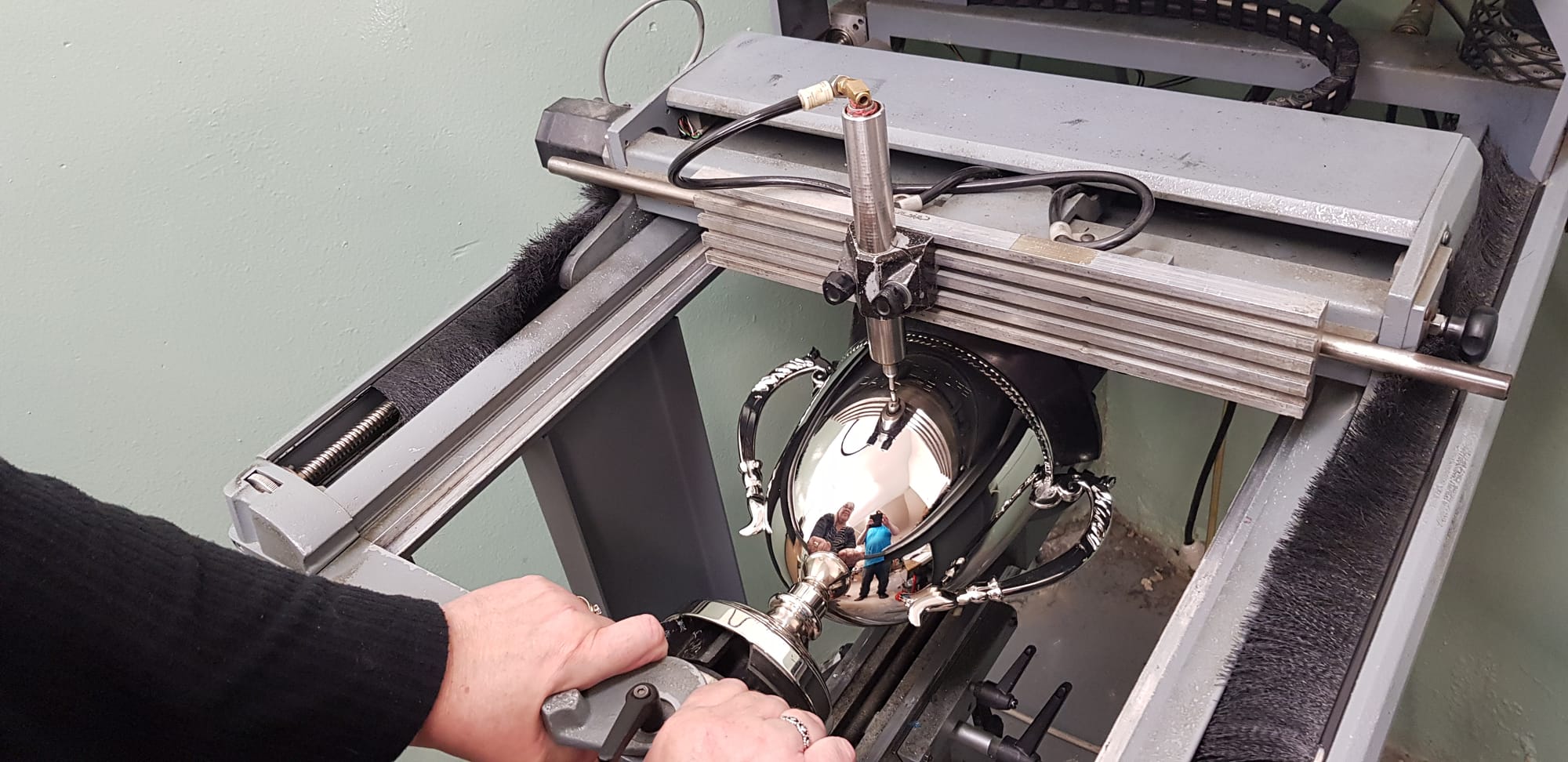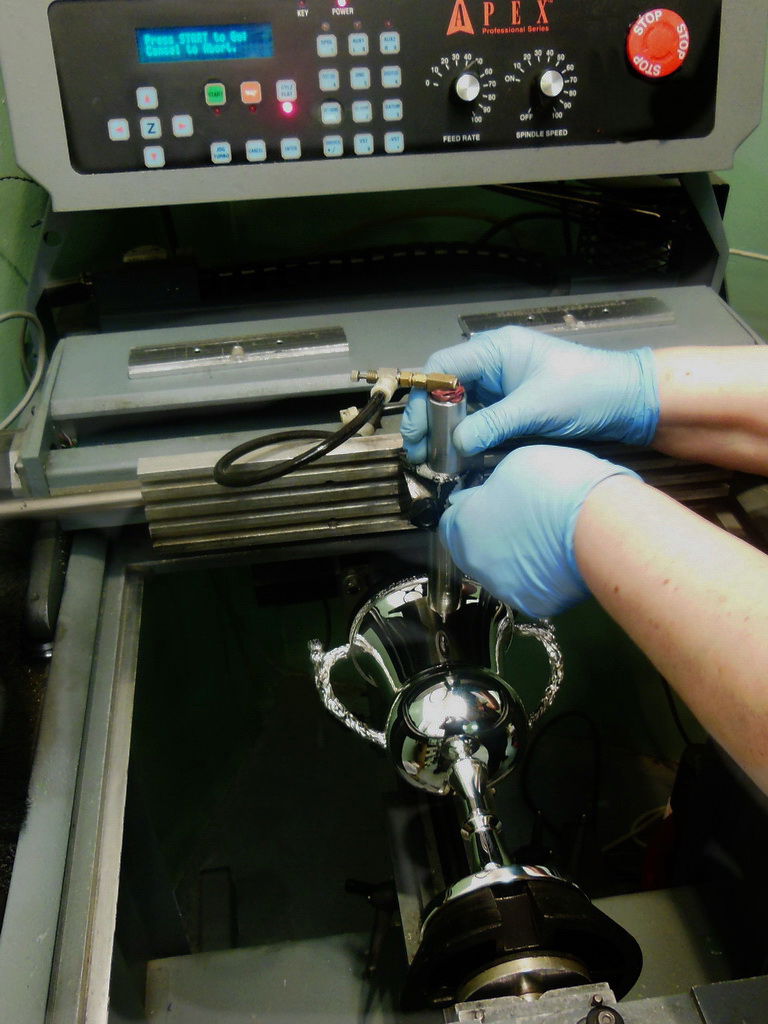Understanding Diamond Drag Engraving: A Comprehensive Guide for Potential Customers


In the world of engraving and awards, there are various techniques used to create intricate designs and inscriptions. One such method that has gained popularity for its precision and durability is diamond drag engraving. If you're considering engraving services for your awards or special keepsakes, understanding diamond drag engraving is essential in making an informed decision.
What is Diamond Drag Engraving?
Diamond drag engraving is a mechanical engraving process that uses a diamond-tipped tool to etch designs and text onto a wide range of materials. Unlike traditional engraving methods that rely on rotary bits, diamond drag engraving involves the use of a non-rotating diamond-tipped tool that is dragged across the surface, creating precise and fine-lined engravings.
How Diamond Drag Engraving Works
- Tool and Material Interaction: The diamond-tipped tool is mounted on an engraving machine, and as the machine moves, the tool is dragged across the material's surface, creating shallow grooves.
- Precision and Durability: The use of a diamond-tipped tool ensures exceptional precision and durability, resulting in long-lasting and detailed engravings.
- Versatility: Diamond drag engraving can be applied to a variety of materials, including metal, plastic, acrylic, glass, and more, making it a versatile choice for different engraving needs.
Benefits of Diamond Drag Engraving Precision and Detail
- Diamond drag engraving excels in producing intricate and detailed designs, making it an ideal choice for intricate logos, fine text, and decorative patterns.
Durability
- The use of a diamond-tipped tool ensures that engravings are highly resistant to wear and tear, ensuring long-lasting quality.
Versatility
- From metal plaques to acrylic awards, diamond drag engraving can be applied to a diverse range of materials, offering flexibility for various engraving projects.
- Pressure and Speed Control: The engraving machine controls the pressure exerted by the diamond-tipped tool on the material, as well as the speed at which the tool moves. These factors are carefully calibrated to achieve the desired depth and precision of the engravings.
Precision and Detail
- Fine-Lined Engravings: The diamond-tipped tool's interaction with the material results in precise and fine-lined engravings, allowing for intricate designs, detailed text, and decorative patterns to be accurately reproduced.
- Consistency and Repeatability: The controlled movement of the diamond-tipped tool ensures consistency across multiple engravings, maintaining uniformity and high-quality results.
Versatility and Adaptability
- Material Compatibility: Diamond drag engraving can be applied to a diverse range of materials, allowing for versatility in engraving projects, from metal plaques to acrylic awards and beyond.
- Customisation and Personalisation: The engraving process can be tailored to accommodate custom designs, logos, text, and other personalised elements, catering to individual preferences and specific requirements.
End Result
- Durability and Longevity: The use of a diamond-tipped tool ensures that engravings are highly resistant to wear and tear, guaranteeing long-lasting quality and enduring impressions.
- Professional Aesthetics: The precise and clean lines achieved through diamond drag engraving result in a professional and polished aesthetic, adding a touch of sophistication to the finished product.
In summary, the diamond drag engraving process combines precision, durability, and versatility to create enduring and detailed engravings on a wide array of materials. This meticulous technique, facilitated by specialised equipment and meticulous control, results in high-quality, professional-grade engravings that are well-suited for awards, industrial applications, personalised gifts, and more.
Here's a step-by-step explanation of the diamond drag engraving process:
Step 1: Material Preparation
- Secure Placement: The material to be engraved, such as metal, plastic, acrylic, or glass, is securely placed within the engraving machine, ensuring proper alignment and stability for accurate engraving.
Step 2: Tool Setup
The diamond drag engraving process is a specialized method that involves intricate and precise etching of designs and text onto various materials using a diamond-tipped tool. Here's an elaborate explanation of the engraving process:
1. Material Preparation and Alignment
- The process begins with the selection of the material to be engraved, which can range from metals to plastics, acrylics, and glass. The material is securely placed within the engraving machine to ensure proper alignment and stability during the engraving process.
2. Tool Setup and Calibration
- A diamond-tipped tool, known for its exceptional hardness and durability, is carefully installed onto the engraving machine. The machine is then calibrated to control the pressure exerted by the diamond-tipped tool on the material and the speed at which the tool moves. These settings are crucial for achieving the desired depth and precision of the engravings.
3. Design Input and Customisation
- The design or text to be engraved is input into the engraving machine's software. This could include customised logos, names, dates, decorative patterns, or any other personalised elements. The software allows for precise customisation and detailed design specifications.
4. Controlled Engraving Process
- As the engraving machine is activated, the diamond-tipped tool is brought into contact with the material's surface. Unlike traditional rotary engraving methods, the diamond-tipped tool is dragged across the surface, creating shallow grooves with exceptional precision.
- The controlled movement of the diamond-tipped tool ensures consistent pressure and speed, resulting in precise and fine-lined engravings. This meticulous process allows for the creation of intricate designs and detailed text with exceptional accuracy.
5. Quality Inspection and Finishing
- Once the engraving process is complete, the engraved material undergoes a thorough visual inspection to ensure that the engravings meet the specified design requirements and quality standards. Any necessary touch-ups or finishing details are attended to at this stage to ensure the final product meets the highest standards of craftsmanship.
6. End Result
- The resulting engravings exhibit durability and professional aesthetics, characterised by clean and precise lines. The use of a diamond-tipped tool ensures that the engravings are highly resistant to wear and tear, guaranteeing long-lasting quality and enduring impressions.
- Diamond-Tipped Tool Installation: A diamond-tipped tool is mounted onto the engraving machine. This tool will be responsible for creating the engravings on the material's surface.
- Step 3: Machine Calibration
- Pressure and Speed Settings: The engraving machine is calibrated to control the pressure exerted by the diamond-tipped tool on the material and the speed at which the tool moves. These settings are crucial for achieving the desired depth and precision of the engravings.
- Step 4: Design Input
- Design Specification: The design or text to be engraved is input into the engraving machine's software. This could include customised logos, names, dates, or any other personalised elements.
- Step 5: Engraving Process
- Tool Interaction with the Material: As the machine is activated, the diamond-tipped tool is dragged across the surface of the material. The non-rotating nature of the tool allows it to create shallow grooves, resulting in the desired engravings.
- Controlled Movement: The machine ensures controlled movement of the diamond-tipped tool, maintaining consistent pressure and speed to achieve precise and fine-lined engravings.
- Step 6: Quality Inspection
- Visual Assessment: Once the engraving process is complete, the engraved material is inspected visually to ensure that the engravings meet the specified design requirements and quality standards.
- Step 7: Final Product
- Durability and Aesthetics: The resulting engravings exhibit durability and professional aesthetics, characterised by clean and precise lines, adding a touch of sophistication to the finished product.
- In conclusion, the step-by-step diamond drag engraving process involves meticulous preparation, precise tool setup, calibration, controlled engraving, quality inspection, and ultimately, the creation of enduring and detailed engravings on a variety of materials. This process ensures that the final product meets the highest standards of precision, durability, and visual appeal, making it an ideal choice for awards, industrial applications, personalised gifts, and more.
- In summary, the diamond drag engraving process is a meticulously controlled and detailed method that combines precision, durability, and versatility to create enduring and detailed engravings on a wide array of materials. This process ensures that the final product meets the highest standards of precision, durability, and visual appeal, making it an ideal choice for awards, industrial applications, personalised gifts, and more. There are several engraving techniques used to create intricate designs and inscriptions on various materials. Here are some of the most common engraving techniques:
- 1. Diamond Drag Engraving
- Description: Diamond drag engraving involves the use of a non-rotating diamond-tipped tool that is dragged across the surface of the material, creating precise and fine-lined engravings. The process is known for its precision, durability, and versatility across different materials.
- Materials: Suitable for metals, plastics, acrylics, and glass, making it a versatile choice for various engraving needs.
- Applications: Widely used for awards, industrial tags, personalised gifts, and more.
- 2. Rotary Engraving
- Description: Rotary engraving utilises a rotating cutting tool to remove material and create engravings. This technique is versatile and can be used for a wide range of materials.
- Materials: Suitable for metals, plastics, wood, and various other materials.
- Applications: Commonly used for signage, nameplates, jewellery, and industrial components.
- 3. Laser Engraving
- Description: Laser engraving uses a high-powered laser to remove the surface of the material, creating precise and detailed engravings. It is known for its speed and ability to produce intricate designs.
- Materials: Suitable for wood, acrylic, glass, leather, and some metals.
- Applications: Used for personalised items, promotional products, signage, and industrial marking.
- 4. Hand Engraving
- Description: Hand engraving involves the use of handheld tools such as gravers and burins to carve designs into the material's surface. This technique allows for intricate and artistic engravings.
- Materials: Suitable for metals, jewellery, and artistic applications.
- Applications: Often used for custom jewellery, artistic designs, and restoration of engraved items.
- 5. CNC Engraving
- Description: CNC (Computer Numerical Control) engraving involves the use of computer-controlled machines to create precise engravings. It offers high accuracy and repeatability.
- Materials: Suitable for metals, plastics, wood, and other materials.
- Applications: Commonly used for industrial components, signage, and custom products.
- Each engraving technique offers unique advantages in terms of precision, speed, material compatibility, and artistic potential. The choice of engraving technique depends on the specific requirements of the project, the material being engraved, and the desired outcome in terms of design and durability.


